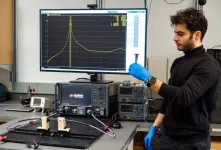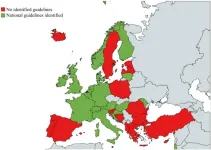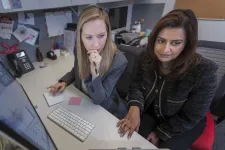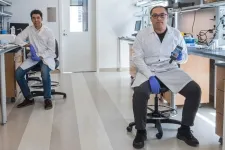(Press-News.org) In a first-of-its-kind development, UBC Okanagan researchers, in collaboration with Drexel University, have created a new compound that can be used to 3D print telecommunication antennas and other connectivity devices.
These 3D printed products, created by combining a two-dimensional compound called MXenes with a polymer, can be used as an alternative for metallic counterparts and can make a vast improvement in communication technology including elements such as antennas, waveguides and filters.
Waveguides are everywhere, yet most people don’t know what they are, says Dr. Mohammad Zarifi, a researcher in UBC Okanagan’s Microelectronics and Gigahertz Applications (OMEGA) Lab.
Waveguides are structures or pipes that help direct sound and optical waves in communication devices and consumer appliances like microwaves. Waveguides vary in size, but historically they are made of metal due to their conductive attributes.
Dr. Zarifi and his OMEGA team develop state-of-the-art communication components that have a compatible performance to metal, but are 10 to 20 times lighter, less expensive and easy to build.
“In the ever-evolving landscape of technology, waveguides—a foundation in devices we use daily—are undergoing a transformative shift,” explains Dr. Zarifi, an Associate Professor with the School of Engineering. “From the familiar hum of microwave ovens to the vast reach of satellite communication, these integral components have traditionally been made from metals like silver, brass and copper.”
MXenes are an emerging family of two-dimensional materials—with the titanium carbide MXene being a leader in terms of electrical conductivity, explains Dr. Yury Gogotsi, Director of the A.J. Drexel Nanomaterials Institute at Drexel University in Philadelphia
“Think of MXenes as nanometre-thin conductive flakes that can be dispersed in water-like clay,” Dr. Gogotsi says “This is a material that can be applied from dispersion in pure water with no additives to almost any surface. After drying in air, it can make polymer surfaces conductive. It’s like metallization at room temperature, without melting or evaporating a metal, without vacuum or temperature.”
Integration of MXenes onto 3D-printed nylon-based parts allows a channel-like structure to become more efficient in guiding microwaves to frequency bands. This capability in a lightweight, additively manufactured component can impact the design and manufacturing of electronic communication devices in the aerospace and satellite industry, explains Omid Niksan, a UBCO School of Engineering doctoral student and first author of the article.
“Whether in space-based communication devices or medical imaging equipment like MRI machines, these lightweight MXene-coated polymeric structures have the potential to replace traditional manufacturing methods such as metal machining for creating channel structures,” he adds.
The researchers have a provisional patent on the polymer-based MXene-coated communication components. And Dr. Zarifi notes the potential of this equipment is sky-high.
“While there is still additional research to be done, we’re excited about the potential of this innovative material.,” says Dr. Zafiri. “We aim to explore and develop the possibilities of 3D printed antennas and communication devices in space. By reducing payloads of shuttle transporters, it gives engineers more options.”
The research was conducted in collaboration with scientists from Drexel University's A.J. Drexel Nanomaterials Institute and supported by the Department of National Defence, the Natural Sciences and Engineering Research Council and the United States National Science Foundation. It was published in the latest edition of the journal Materials Today.
END
UBC Okanagan researchers create new compound to build space-age antennas
Light-weight, 3D printed devices can change the face of satellite communication
2024-02-29
ELSE PRESS RELEASES FROM THIS DATE:
Study detects cognitive changes in older drivers using in-vehicle sensors
2024-02-29
An estimated 4 to 8 million older adults with mild cognitive impairment are currently driving in the United States, and one-third of them will develop dementia within five years. Individuals with progressive dementias are eventually unable to drive safely, yet many remain unaware of their cognitive decline.
Currently, screening and evaluation services for driving can only test a small number of individuals with cognitive concerns, missing many who need to know if they require treatment.
Nursing, engineering and neuropsychology researchers at Florida Atlantic University are testing and evaluating a readily and rapidly available, unobtrusive in-vehicle sensing ...
Terasaki Institute for Biomedical Innovation announces 2024 Paul Terasaki Award recipient
2024-02-29
(LOS ANGELES) – February 29, 2024 - The Terasaki Institute for Biomedical Innovation (TIBI) is pleased to announce their selection of Professor Nicholas A. Peppas of The University of Texas at Austin as the recipient of the 2024 Paul Terasaki Distinguished Scientist Innovation Award. The award will be presented at TIBI’s 2nd annual Terasaki Innovation Summit, to be held March 27-29, 2024, at the UCLA Meyer & Renee Luskin Conference Center.
The award was created in memory of Dr. Paul I. Terasaki, a pioneer in organ transplant research and innovation. It recognizes outstanding achievement in the field of biomedical ...
Terasaki Institute for Biomedical Innovation announces 2024 Hisako Terasaki Award recipients
2024-02-29
(LOS ANGELES) – February 29, 2024 - The Terasaki Institute for Biomedical Innovation (TIBI) is pleased to announce their selections of Assistant Professors Amir Manbachi of Johns Hopkins University and Ritu Raman of the Massachusetts Institute of Technology (MIT) as the recipients of the 2024 Hisako Terasaki Young Innovator Awards. The awards will be presented at TIBI’s 2nd annual Terasaki Innovation Summit, to be held March 27-29, 2024, at the UCLA Meyer & Renee Luskin Conference Center.
The award was created in memory of Hisako Terasaki, philanthropist, accomplished artist, and wife ...
Small dietary changes can cut your carbon footprint by 25%
2024-02-29
The latest Canada’s Food Guide presents a paradigm shift in nutrition advice, nixing traditional food groups, including meat and dairy, and stressing the importance of plant-based proteins. Yet, the full implications of replacing animal with plant protein foods in Canadians’ diets are unknown.
New research at McGill University in collaboration with the London School of Hygiene & Tropical Medicine provides compelling evidence that partially substituting animal with plant protein foods can increase life expectancy and decrease greenhouse gas emissions. Importantly, ...
Uncertainty in measuring biodiversity change could hinder progress towards global targets for nature
2024-02-29
More than ever before, there is a growing interest in dedicating resources to stop the loss of biodiversity, as recently exemplified by the Kunming-Montreal Global Biodiversity Framework (GBF) decided at COP15 in December 2022. The GBF focuses on understanding why biodiversity is declining and what actions are needed to reverse this trend. However, according to researchers at McGill University, implementing the plan is challenging because information about biodiversity changes is not evenly available everywhere, and is uncertain in many places.
With the available data, can the ...
Zero emissions of carbon dioxide! Successful production of ammonia-based clean hydrogen
2024-02-29
Dr. Jung Unho's research team at the Hydrogen Research Department of the Korea Institute of Energy Research (KIER) has developed Korea's first clean hydrogen production technology. This technology is based on ammonia decomposition and does not use fossil fuels. The team's breakthrough could pave the way for a more sustainable and eco-friendly energy source. This allows for the production of high-purity hydrogen that meets international standards for hydrogen-powered vehicles, without the carbon dioxide emissions produced by using fossil fuels.
Ammonia, a compound of hydrogen and nitrogen, has a hydrogen storage density 1.7 times ...
Guiding future research on ‘extraordinary potential’ of next-generation solar cells
2024-02-29
Today’s commercial solar panels can convert about 15% to 20% of the sunlight they absorb into electrical energy — but they could be much more efficient, according to researchers at Soochow University. The next generation of solar cells has already demonstrated 26.1% efficiency, they said, but more specific research directions are needed to make such efficiency the standard and expand beyond it.
They published their review of the current state of research on high-efficiency perovskite solar cells and their recommendations for future work in Energy Materials and Devices on February 4.
“Metal halide perovskite ...
Urgent need for guidelines for the care of child victims of sexual abuse
2024-02-29
Only half of 34 surveyed European countries have national guidelines on how to provide clinical care and treatment to children who have experienced sexual abuse. This finding was revealed in a study led by researchers at Barnafrid, a national knowledge centre in the field of violence and other abuse against children, at Linköping University in Sweden. The consequences for the affected children can be severe, according to the researchers.
“Our findings suggest that children in Europe may not receive equal care. From a child rights perspective, this is unacceptable. ...
Overcoming barriers to conducting clinical trials in childhood rare disease research
2024-02-29
Using a novel methodology, researchers at The Hospital for Sick Children (SickKids) are the first in paediatric research to use data from an international real-world cohort to overcome the barriers associated with conducting randomized clinical trials in children with rare diseases.
The gold standard for evaluating new therapeutics is through randomized clinical trials, where one group of individuals receives treatment while another does not. Unfortunately, conducting this type of clinical trial proves challenging for many rare conditions due to the limited number of individuals with the condition, making meaningful comparisons difficult. Additionally, ...
Faster and simpler point-of-care malaria test developed by Rice researchers
2024-02-29
Rice University researchers have developed a rapid, accurate test for diagnosing malaria that is significantly faster and easier to use than traditional tests. The advancement has the potential to improve patient outcomes, especially in rural regions with limited health care resources.
Malaria remains a significant global health challenge with an estimated 247 million cases and more than 600,000 deaths annually, the majority of which occur in sub-Saharan Africa. The most severe form, cerebral malaria, has a high mortality ...
LAST 30 PRESS RELEASES:
New expert guidance urges caution before surgery for patients with treatment-resistant constipation
Solar hydrogen can now be produced efficiently without the scarce metal platinum
Sleeping in on weekends may help boost teens’ mental health
Study: Teens use cellphones for an hour a day at school
After more than two years of war, Palestinian children are hungry, denied education and “like the living dead”
The untold story of life with Prader-Willi syndrome - according to the siblings who live it
How the parasite that ‘gave up sex’ found more hosts – and why its victory won’t last
When is it time to jump? The boiling frog problem of AI use in physics education
Twitter data reveals partisan divide in understanding why pollen season's getting worse
AI is quick but risky for updating old software
Revolutionizing biosecurity: new multi-omics framework to transform invasive species management
From ancient herb to modern medicine: new review unveils the multi-targeted healing potential of Borago officinalis
Building a global scientific community: Biological Diversity Journal announces dual recruitment of Editorial Board and Youth Editorial Board members
Microbes that break down antibiotics help protect ecosystems under drug pollution
Smart biochar that remembers pollutants offers a new way to clean water and recycle biomass
Rice genes matter more than domestication in shaping plant microbiomes
Ticking time bomb: Some farmers report as many as 70 tick encounters over a 6-month period
Turning garden and crop waste into plastics
Scientists discover ‘platypus galaxies’ in the early universe
Seeing thyroid cancer in a new light: when AI meets label-free imaging in the operating room
Neutrophil-to-lymphocyte ratio may aid risk stratification in depressive disorder
2026 Seismological Society of America Annual Meeting
AI-powered ECG analysis offers promising path for early detection of chronic obstructive pulmonary disease, says Mount Sinai researchers
GIMM uncovers flaws in lab-grown heart cells and paves the way for improved treatments
Cracking the evolutionary code of sleep
Medications could help the aging brain cope with surgery, memory impairment
Back pain linked to worse sleep years later in men over 65, according to study
CDC urges ‘shared decision-making’ on some childhood vaccines; many unclear about what that means
New research finds that an ‘equal treatment’ approach to economic opportunity advertising can backfire
Researchers create shape-shifting, self-navigating microparticles
[Press-News.org] UBC Okanagan researchers create new compound to build space-age antennasLight-weight, 3D printed devices can change the face of satellite communication









